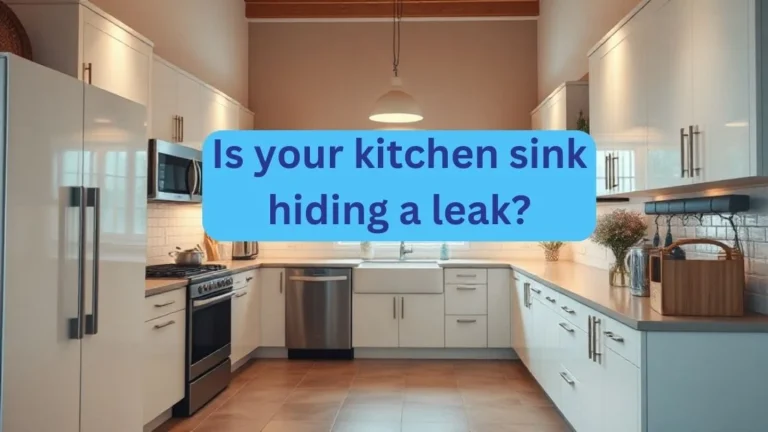A leaking kitchen sink can be both annoying and wasteful, potentially leading to water damage if not fixed quickly. Knowing the usual suspects can help you tackle the problem efficiently. In this post, we identify the common culprits behind kitchen sink leaks, providing tips to help you diagnose and resolve these issues effectively.
Key Takeaways
- Worn-out washers and gaskets are common sources of leaks due to degradation from frequent use, necessitating regular inspections and replacements.
- Corroded pipes weaken integrity, often leading to leaks at joints; maintenance and corrosion-resistant materials can help prevent this issue.
- Loose connections from improper installation can create vulnerable points; regularly tightening fittings can mitigate potential leaks.
- Damaged seals around taps and drains can lead to water escape, making regular cleaning and seal inspections essential for prevention.
- Clogged drains can cause pressure build-up, leading to leaks; routine cleaning and using strainers can help avoid blockages.
Common Leak Causes
In relation to kitchen sink leaks, several common causes can lead to frustrating and costly issues. One prevalent factor is seal deterioration, as faulty seals and gaskets wear out over time due to continuous exposure to water pressure and temperature fluctuations.
Moreover, pipe misalignment from improper installation can create vulnerable points in your plumbing, resulting in leaks that can escalate if not addressed promptly. Ageing plumbing systems are particularly at risk, with corrosion and deterioration increasing the likelihood of water loss.
In addition, loose or damaged pipes often develop leaks, especially at connection points, while clogged drains can cause water backup, leading to leaks throughout the system.
Regular maintenance and inspections are essential for mitigating these risks and preserving your kitchen’s integrity. But there may be other dangers of ignoring sink leaks in your home.
Locating the Leak Source
Identifying the source of a leak under the kitchen sink requires a systematic approach to ensure effective resolution.
Begin with thorough leak detection by examining visible water stains or dampness on pipes, which can help pinpoint the exact area of leakage. Pay special attention to the P-trap, as this curved section often suffers from loose connections or corrosion.
Assess the water supply lines, particularly at joints connecting to the tap or shut-off valves, for any signs of leakage. Furthermore, look for pooling water on the floor or cabinet base, which can illuminate the leak’s origin, especially around drain connections.
A torch can aid in moisture assessment, revealing hidden leaks or dampness in dark areas that might otherwise go unnoticed.
Inspecting Faucet Leaks
Inspecting faucet leaks requires a keen awareness of common sources and signs, such as water pooling at the base or dampness concealed beneath the sink.
Identifying whether the issue stems from worn washers or gaskets is essential for determining if a simple repair will suffice or if a replacement is necessary.
Common Leak Sources
A thorough examination of faucet leaks is essential for maintaining an efficient kitchen sink. Common sources of leaks include washer deterioration, corroded valve seats, and pressure fluctuations. Over time, worn-out washers or O-rings can lead to water pooling, while high water pressure can exacerbate these issues. Regular maintenance, such as replacing old washers every six months, is vital to prevent further damage.
| Leak Source | Cause | Preventive Measure |
|---|---|---|
| Washer Deterioration | Wear and tear | Replace every 6 months |
| Corroded Valve Seats | Mineral buildup | Regular inspection and cleaning |
| Pressure Fluctuations | High pressure levels | Install pressure regulators |
Signs of Faucet Leaks
Faucet leaks can lead to significant water wastage and potential damage if left unchecked. One of the most apparent signs is visible water pooling at the base of the faucet, often resulting from worn-out washers or O-rings.
However, leaks can also occur beneath the sink, hidden from plain sight, requiring diligent inspection of all connections and components. Regular maintenance of taps is essential; old washers or gaskets may need replacing to effectively stop leaks.
Moreover, monitoring for dampness around the tap and nearby areas aids in early leak detection, preventing escalation into larger issues. While complete tap replacement is rare, persistent leaks may signal deeper problems that could benefit from professional evaluation.
Repair or Replace?
Understanding the nuances of faucet leaks is essential for effective maintenance and repair. Common culprits include worn-out washers and O-rings, which are easily replaceable and can stop leaks, restoring functionality.
However, corroded valve seats may require more intricate disassembly, demanding a higher level of faucet maintenance. Furthermore, high water pressure can exacerbate leaks, making it vital to monitor and adjust pressure levels during leak prevention efforts.
Regular inspections of the faucet handle and base for visible pooling can indicate leaks, warranting deeper investigation into seals and fittings.
If minor repairs do not resolve the issue, consider complete faucet replacement, especially in cases of severe corrosion. Prioritise long-term solutions for a leak-free kitchen experience.
Evaluating Drain Seal Issues
Effective maintenance of drain seals is essential for ensuring the integrity of a kitchen sink’s plumbing system. A loose drain seal can lead to significant leaks, often evidenced by water pooling around the sink area.
Regular inspection for tightness and integrity is critical; without it, a faulty seal can prevent water from being contained, necessitating prompt replacement to avert further leaks.
When addressing drain seal issues, it is important to apply new adhesive during installation, ensuring a secure fit that enhances durability.
DIY Repair Strategies
DIY repair strategies for kitchen sink leaks can save homeowners both time and money while empowering them to take control of their plumbing issues. Begin by shutting off the water supply to prevent further leakage. Use an adjustable spanner to tighten loose fittings, a common cause of leaks. Inspect and replace damaged washers or O-rings, as worn seals often lead to dripping taps. Employ plumber’s tape on threaded connections for a secure seal during reassembly. After repairs, restore the water supply and conduct thorough leak detection to verify success.
| Step | Action | Purpose |
|---|---|---|
| Shut off water supply | Prevent further leaks | Safety initially |
| Tighten fittings | Secure connections | Avoid common leak sources |
| Replace washers | Fix worn seals | Stop dripping |
| Use plumber’s tape | Ensure tight seal | Prevent future leaks |
| Test for leaks | Confirm repair success | Verify peace of mind |
When to Call Professionals
Navigating the complexities of plumbing can often lead to frustration, particularly when leaks persist despite careful attempts at repair.
If you find yourself dealing with ongoing leaks or significant increases in your water bill, it is crucial to seek a professional assessment. These signs may indicate underlying plumbing emergencies that require expert diagnosis.
Recurrent clogs, despite regular maintenance, suggest deeper structural issues that could jeopardise your home’s integrity. Furthermore, visible water damage or dampness around your kitchen sink warrants immediate attention to prevent mould growth and further damage.
Complex plumbing problems, such as corroded pipes, necessitate specialised tools and expertise that only trained professionals possess. Recognising these causes of leaking pipes can save you time, money, and stress in the long run.
Long-Term Prevention Tips
Maintaining a proactive approach to kitchen sink care can significantly reduce the risk of leaks and costly repairs.
Implementing a routine of preventive maintenance is essential; inspect and replace worn-out washers, gaskets, and seals every six months to ensure effective sealing. Use high-quality, rust-resistant materials to combat corrosion and wear.
Annual professional plumbing inspections facilitate early leak detection, safeguarding the longevity of your plumbing system.
Furthermore, keep drains clear with regular cleaning using vinegar and bicarbonate of soda, preventing blockages that could lead to leaks.
Monitor water pressure and adjust with a pressure regulator if necessary, as excessive pressure may result in sudden failures.
Dealing with a persistent leak under your kitchen sink?
Don’t let it spiral into a costly repair bill. Our professional leak detection service will get to the root of the problem quickly, saving you time, money, and stress. Whether it’s a worn seal, corroded pipe, or hidden damage, we’ll find it and fix it fast.
Stop the leak before it turns into a full-blown plumbing emergency! Contact us today for a thorough assessment and enjoy peace of mind.
P.S. A leak today could be a bigger problem tomorrow—schedule your expert inspection now and protect your home and wallet.



